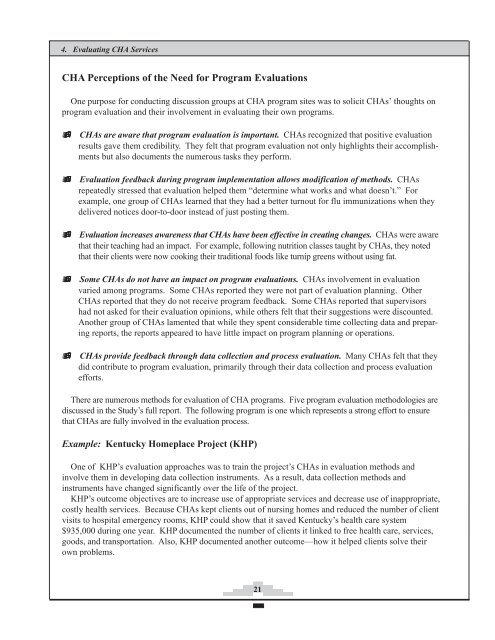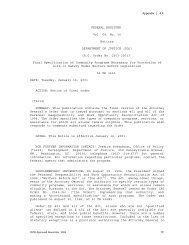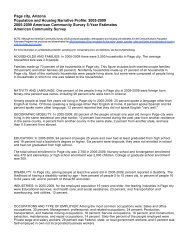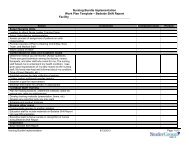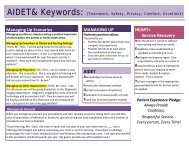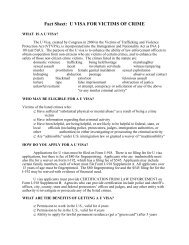4. Evaluating CHA Services
4. Evaluating CHA Services
4. Evaluating CHA Services
- No tags were found...
Create successful ePaper yourself
Turn your PDF publications into a flip-book with our unique Google optimized e-Paper software.
<strong>4.</strong> <strong>Evaluating</strong> <strong>CHA</strong> <strong>Services</strong><br />
<strong>CHA</strong> Perceptions of the Need for Program Evaluations<br />
One purpose for conducting discussion groups at <strong>CHA</strong> program sites was to solicit <strong>CHA</strong>s’ thoughts on<br />
program evaluation and their involvement in evaluating their own programs.<br />
<strong>CHA</strong>s are aware that program evaluation is important. <strong>CHA</strong>s recognized that positive evaluation<br />
results gave them credibility. They felt that program evaluation not only highlights their accomplishments<br />
but also documents the numerous tasks they perform.<br />
Evaluation feedback during program implementation allows modification of methods. <strong>CHA</strong>s<br />
repeatedly stressed that evaluation helped them “determine what works and what doesn’t.” For<br />
example, one group of <strong>CHA</strong>s learned that they had a better turnout for flu immunizations when they<br />
delivered notices door-to-door instead of just posting them.<br />
Evaluation increases awareness that <strong>CHA</strong>s have been effective in creating changes. <strong>CHA</strong>s were aware<br />
that their teaching had an impact. For example, following nutrition classes taught by <strong>CHA</strong>s, they noted<br />
that their clients were now cooking their traditional foods like turnip greens without using fat.<br />
Some <strong>CHA</strong>s do not have an impact on program evaluations. <strong>CHA</strong>s involvement in evaluation<br />
varied among programs. Some <strong>CHA</strong>s reported they were not part of evaluation planning. Other<br />
<strong>CHA</strong>s reported that they do not receive program feedback. Some <strong>CHA</strong>s reported that supervisors<br />
had not asked for their evaluation opinions, while others felt that their suggestions were discounted.<br />
Another group of <strong>CHA</strong>s lamented that while they spent considerable time collecting data and preparing<br />
reports, the reports appeared to have little impact on program planning or operations.<br />
<strong>CHA</strong>s provide feedback through data collection and process evaluation. Many <strong>CHA</strong>s felt that they<br />
did contribute to program evaluation, primarily through their data collection and process evaluation<br />
efforts.<br />
There are numerous methods for evaluation of <strong>CHA</strong> programs. Five program evaluation methodologies are<br />
discussed in the Study’s full report. The following program is one which represents a strong effort to ensure<br />
that <strong>CHA</strong>s are fully involved in the evaluation process.<br />
Example: Kentucky Homeplace Project (KHP)<br />
One of KHP’s evaluation approaches was to train the project’s <strong>CHA</strong>s in evaluation methods and<br />
involve them in developing data collection instruments. As a result, data collection methods and<br />
instruments have changed significantly over the life of the project.<br />
KHP’s outcome objectives are to increase use of appropriate services and decrease use of inappropriate,<br />
costly health services. Because <strong>CHA</strong>s kept clients out of nursing homes and reduced the number of client<br />
visits to hospital emergency rooms, KHP could show that it saved Kentucky’s health care system<br />
$935,000 during one year. KHP documented the number of clients it linked to free health care, services,<br />
goods, and transportation. Also, KHP documented another outcome—how it helped clients solve their<br />
own problems.<br />
21


